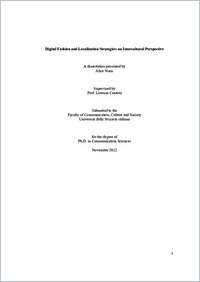Digital fashion and localization strategies : an intercultural perspective
- Norris, Alice
- Cantoni, Lorenzo (Degree supervisor)
- 2022
PhD: Università della Svizzera italiana
English
Reading the title of this doctoral thesis, one might wonder how it could be possible to connect fashion research with the adjectives digital and intercultural. Digital Fashion and Localization Strategies: an Intercultural Perspective aims to present the intersection of the digital world, culture and fashion when doing research in the field of communication. It proposes a series of academic research and studies related to the topic of online localization in fashion. By localization we mean the process of cultural adaptation/translation that enables fashion stakeholders to digitally approach new markets and audiences. The thesis in this direction, investigates how companies choose (or not) to modify and adapt their online contents to market their products. Moreover, it presents what can happen when localization and cultural adaptation are absent from digital media or are shown to be inadequate and thus generate communication crises. Each chapter of the thesis presents a specific aspect of the research conducted from 2019 to 2022. The opening section of the thesis, Part I (chapter 1), presents the theoretical framework that made possible to pursue the research by first defining the concept of communication and then presenting three specific areas of study related to it, namely digital communication, intercultural communication and fashion communication. Once the theoretical framework has been presented, in Part II (chapters 2-3), the research guide explains how the research gap was identified and presents the research design. Part II offers a brief overview of the contents of each paper or book chapter that compose the thesis. Part III (chapter 4) presents the three research questions addressed: (i) what is online localization in fashion? (ii) compared to the definitions of localization provided in previous studies, has the concept evolved over time and, if so, how? (iii) in the digital environment, can a lack of or an erroneous localization generate crises? Of which kind? In addition, the section investigates the predominantly post-positivist epistemological approach and the methodologies used: literature review and systematic literature review, semi-structured qualitative interview, content analysis, grounded theory, thematic analysis and digital analytics. Part IV (chapters 5-6) presents the systematic literature review and literature review, which were at the beginning of the doctoral program, to map the field of digital fashion communication and to identify the research gaps. Part V (chapter 7) presents the topic of digital fashion in relation to pop culture. It considers the following areas: tales, magazines, photography, film, television, music, sport, and some other interchanges including gaming and museums and it offers insights into the term "pop" when related to different cultures. Indeed, within fashion what may be considered "popular" by a certain people/community may not be so for another, and this may not only lead to misunderstandings but also to communication crises. Part VI (chapters 8 and 9) investigates localization and its interconnection with (pop)culture. It discusses how the "standardization versus adaptation (or localization)" debate has taken center stage in the communication and marketing strategies of companies and stakeholders. The continuous increase in the use of ICTs and of the Internet has led in fact, fashion companies to reflect on their digital localization strategies and to delve into how to approach new markets to avoid possible crises generated by cultural misunderstandings. The section also allows the reader to understand what fashion managers think about localization, whether they use it, and what values and declinations they provide to the concept. Part VI also serves as a key introduction to Part VII. The nuances of localization that have emerged in this section, namely localization on eCommerce, social media, and during Covid19, have created fertile ground for delving deeper into these three topics in Part VII. Part VII (chapters 10 - 11 - 12) presents research related to localization on eCommerce, social media, and during Covid19. Regarding eCommerce, the section explores the topic of localization on eCommerce platforms by conducting a content analysis of 4 fashion brands. As per social media research, it presents the case study of the company Caruso, which launched on its YouTube channel the 3-episode story "The Good Italian" as a tool to promote its brand. Finally, it researches the localization strategies implemented by fashion brands on Instagram during the Covid19 pandemic by conducting a content analysis on 25 selected fashion companies. Part VIII (chapters 13-14) aims to address communication crises that have occurred due to intercultural communication misunderstandings in the fashion environment. It deals with the case of Donata Meirelles, former editor-in-chief of Vogue Brasil, who had to resign from her role after she was accused on social media of organizing a "slavery"-themed birthday party. Many social media users in fact, interpreted the choice of party theme as a racist allusion to the colonial era, when Brasil heavily relied on slave labor. The second section of Part VIII presents other intercultural communication crises that have occurred in fashion and have been further amplified by the digital environment. Finally, Part IX (chapter 15) presents the results of this thesis by providing an answer to the three main research questions, by reflecting on managerial implications, possible limitations, and future developments. On one side this thesis can be considered an added value to studies dealing with localization and intercultural communication since it provides a more comprehensive, balanced, and grounded picture on the topic, and on the other, it can be considered a useful tool for practitioners who wish to implement an appropriate localization strategy and want to have a deeper understanding of the aspects related to intercultural communication to avoid crises or, if they occur, to address them in a timely and appropriate manner.
- Collections
- Language
-
- English
- Classification
- Economics
- License
-
License undefined
- Open access status
- green
- Identifiers
-
- NDP-USI 2022COM009
- ARK ark:/12658/srd1326717
- URN urn:nbn:ch:rero-006-121631
- Persistent URL
- https://n2t.net/ark:/12658/srd1326717
Statistics
Document views: 306
File downloads:
- 2022COM009: 2170
